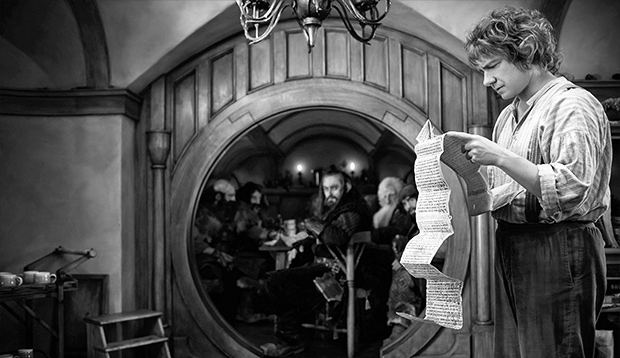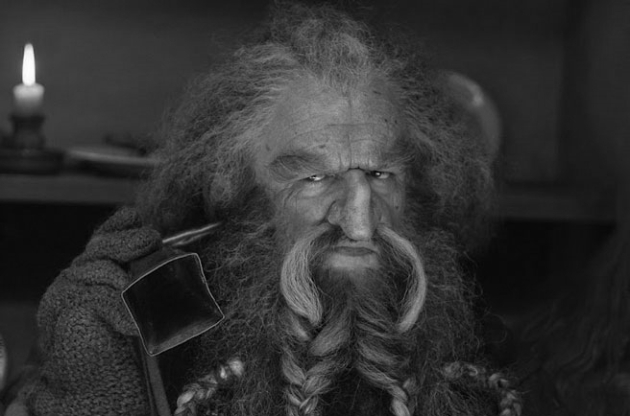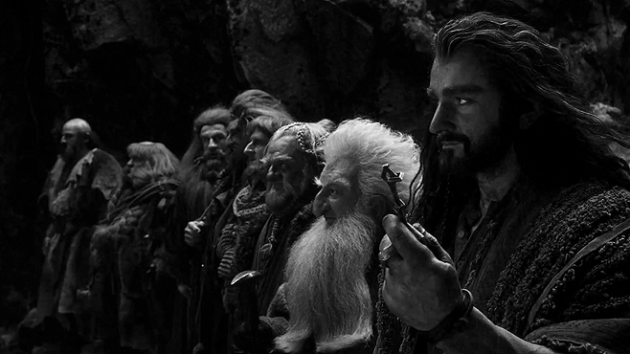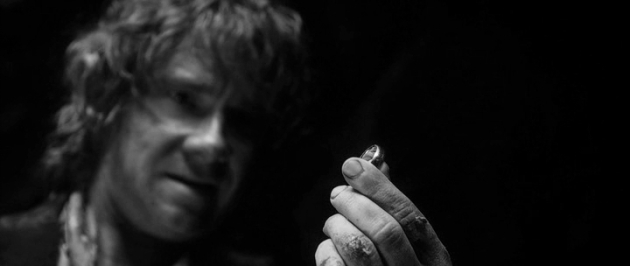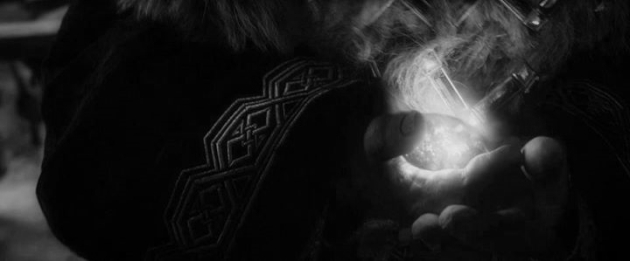The Hobbit trilogy features a unique array of objects that help further the plot and add weight and meaning to the story. These objects of significance play a powerful role in directing our attention toward where exactly the Dwarves and their associates are in their attempt to retake Erebor
These objects are indicators and markers of the status of the quest. By following them and tracing their development, we can see how close or far the company is to accomplishing their ultimate goals. Although the Dwarvish weapons are hugely meaningful to the Company, I’ve already written about the role that having or not having these weapons has on the characters. Instead I want to examine some of the other elements in the films, some common and others not so common.
Oin’s Ear Trumpet
Oin, brother of Gloin, is the medicine man of the company. He is in charge of healing, medicine, and reading the portents relevant to the success of their quest. Aging and partially deaf, Oin carries with him a simple ear trumpet to amplify conversations. He uses this on many occasions, including at the dinner at Bag End and during the elvish music in Rivendell. In addition to helping differentiate Oin from the other twelve dwarves, this ear trumpet always functions as a good measurement of how the company is faring on their quest.
In Bilbo’s house, we are introduced to the instrument in its original state. As the dwarves ravage Bilbo’s pantry and throw food, Dwalin pours ale into Oin’s trumpet to which the elderly sage unceremoniously blows air into the horn ejecting the beverage all over the table. Here at this juncture the horn is part of their recreational destruction, wholly indicative of the relatively happy and benign state of the quest. They are at the beginning and still full of hope. Their many challenges and grim misfortunes lay out of sight.
The trumpet makes a few more appearances but a major shift occurs in the Goblin Tunnels. Captured by a grotesque rabble of goblins, the company sits at the mercy of the wretched Goblin-King. Upon discovering their identities as well as their famous goblin-slaying swords, the king demands they be slaughtered on the spot. During this upheaval, a goblin flattens Oin’s trumpet under his foot. Just like the company’s prospects, the horn is now greatly impaired by their untimely capture deep in the Misty Mountains.
Later in The Desolation of Smaug, the trumpet makes yet another appearance during Tauriel’s healing of Kili at Bard’s house. Oin still has the horn, and he has managed to pry it open and make it usable again. Visibly contorted, the horn is still functional but shows signs of the hardships that the company has faced on their journey. It’s a small but notable visual reminder of how the quest is going. Such subtle touches provide texture, weight, and continuity to a long and winding narrative.
A Map and Key
We most likely will see the origin of these twin objects in the extended edition this November, but we know that Gandalf met Thrain in Dol Guldur and acquired them there. The map and key are crucial objects to the quest, for they are what set the entire affair into motion. In a conversation with Balin at Bag End, Thorin asserts that he must attempt this quest not only as his birthright but because these two objects have now come into his possession as the means to reclaim it.
However like Oin’s horn, the map and key also must go through a type of progression, serving as further indictators of the dwarves’ relative success or failure. The map and key are useless by themselves. Presumably Thorin already knows the layout and terrain of the Lonely Mountain region. He does not need help finding it, he needs directions on how to access it. The key is useless as well without knowing what door it opens and where it is located. At the beginning of the quest, the map and key set things into motion but they also lack the crucial data that the company needs to accomplish their mission. Showing up outside the gates of Erebor without more information will make a nice field trip, but do nothing to advance their greater goals of vanquishing the dragon, reclaiming the Arkenstone, and reestablishing a kingdom under the mountain.
The quest receives a huge boon in Rivendell when Thorin reluctantly provides Elrond access to the map. Using his knowledge of the ancient Dwarvish language and the special properties of moon runes, Elrond reveals the message hidden inside the map. As this information could only be recovered by the light of a perfectly phased moon, this event gives the company not only the physical knowledge of where to go but also the metaphysical suggestion that their quest is somehow sanctioned by a higher power. Enlightened by the news that they must reach Erebor by Durin’s Day, the quest takes on a more defined purpose and shape now. The urgency and immediacy which the decoded map provides is yet another sign that this quest is moving forward and inching closer to its fulfillment.
However the map and key must work in tandem. When Thorin and his companions finally do reach the door as the sun sets on Durin’s Day, they still do not know exactly how to interpret the map nor where precisely to insert the key. The dwarves’ lack of understanding combined with Thorin’s rather extreme impatience lead the company to the brink of failure. With the sunlight gone, Thorin retreats down the side of the mountain leaving only Bilbo behind to reexamine the riddle. Physically abandoning the key, Thorin demonstrates the near futility of the entire quest now left only in the hands of a lowly hobbit. The key has transformed from prize possession to yet another abandoned relic of Durin’s diminished legacy.
When the moonlight finally exposes the riddle’s full meaning and the invisible keyhole, Bilbo searches frantically for the key. In haste he kicks the key into the air and it bounces impossibly off the edge of the mountain. For a short second all is truly lost as our imaginations cast this all important object into oblivion. The quest is over. Smaug shall remain. The North shall fall to shadow. Sauron shall triumph. Middle Earth is lost.
Thorin slams his boot down, barely catching the thin string attached to the flying key. Hanging on the edge of a knife, the quest survives through a mixture of tenacity, sheer luck, and a little divine intervention. All of this can be traced through an object that fits inside the palm of your hand.
Bilbo’s Ring
The Bilbo who left the Shire clutching his contract in hand is the fussy non-adventurous type whose primary values are well cooked meals and the comfort of home. Despite pre-adventure Bilbo’s flaws, he still leaves the Shire clinging to a sense of innocence and idealism that will change over the course of his journey. A major turning point in his development occurs at his acquistion of the ring, a relic which we know to be the near indestructible One Ring forged by the Dark Lord Sauron in the fires of Mount Doom and used to dominate the races of Middle Earth according to his malevolent, all consuming will.
By the time The Fellowship of the Ring occurs, the corruption of Bilbo through the power of the ring will be evident as it causes him to become increasingly erratic, manic, and subjects to uncontrollable fits of rage. This however is only in its beginning stages in The Hobbit. The change however is notable. Bilbo’s relationship to this object can and does influence him in very non-subtle and aggressive ways.
Before Gollum’s cave, Bilbo decides to abandon the quest altogether and sneak off into the night. Rivendell is a suitable substitute for his comfortable hole and he has given up all pretenses of courage, loyalty, and adventure. But after he encounters the Ring, a more ruthless determined Bilbo emerges. He is ready to slay the creature Gollum in cold blood if not for the warm hobbity music that plays in his head the moment he raises his sword.
Upon reaching his companions, Bilbo conceals the truth about the ring refusing to explain just exactly how he escaped the goblins’ lair. Not long after Azog and his wargs attack the company, Bilbo demonstrates a newfound resilience in the face of danger. In a desperate solo act, Bilbo saves Thorin from decapitation with a show of great courage. But is this true courage? Perhaps this is the self-preservation and influence of the Ring at work? The Ring wants to defend its bearer however it can. Could it be both? Either way, the Ring’s presence makes it increasingly difficult to read Bilbo’s actions and distinguish his real motivations. A foreign object now exerts its influence on the quest through Bilbo, but to what purpose?
In Mirkwood, things get even more fuzzy. Bilbo again comes to the rescue and frees the company from the spiders’ webs. But there is a new viciousness that did not exist previously in his soft amiable countenance. We are accustomed to a hobbit who wrinkles his nose and expresses himself with quirky guestures and odd mannerisms. This changed hobbit slashes spiders with a sheer hatred that would be completely unfamiliar to the character we were introduced to in the Shire.
When Bilbo is suddenly seperated from his prize object, he reaches an utterly revealing dimension of transformation. Hacking the baby spider with mad abandon, the hobbit’s ring-induced rage channels the unrestrained depravity of Gollum and delivers none of the traits of the loveable master of Bag End. The One Ring has taken hold, making Bilbo all the more powerful and brave yet increasingly violent and possessive as well.
This duality will help Bilbo survive the hardships of the quest, but it will also slowly poison his soul. When Bilbo is possession of this object, he is more useful to the company and at times absolutely crucial to their quest’s success. The Ring gives Bilbo the strength to overcome his enemies and the tools to outwit his captors, but it also corrupts him beyond saving. We know that one day an unnaturally long-lived Bilbo will board a ship to the West and sail off to the only place that can comfort those who have bourne the agony of this profane object.
The Arkenstone
The King’s Jewel is the grand MacGuffin of the trilogy, but what a glorious one it is. Indeed, the point of the quest is not just ridding history of Smaug but also finding this singular jewel by which Thorin may claim his right to rule over the Dwarven race in the image of his grandfather. If he carries this gem, the other dwarves, including the warriors of the Iron Hills, will pledge their allegiance to him and follow him into battle. After all, even if the company ousts the dragon, they cannot start a civilizations with just thirteen dwarves. Thorin will need a people to rule, and thus he must have the Arkenstone.
In fact, the status of the Arkenstone is the primary indicator of the status of the entire quest. For Thorin, the dragon is a nuisance and an abomination but he can leave him for others like Gandalf and the men of Lake-town to deal with. Thorin just wants the jewel, even if it means awakening an evil that will become a deadly problem for everyone else. Succumbing to the same madness as his fathers before him, Thorin does not hesitate to send Bilbo alone at high risk of death in an attempt to find it. Bilbo, the other dwarves of the company, and Lake-town are affordable casualties if it means repossessing that shiny glittering object.
When Bilbo returns emptyhanded from his encounter with Smaug, Thorin is naturally suspicious and upset. He is quite comfortable threatening the hobbit at swordpoint if it means advancing his purpose. At this point in the story, the goals of Thorin and Bilbo are finally diverging. Bilbo wanted to help Thorin reclaim his homeland, but to what end? To the destruction of Lake-town? To the unleashing of dragonfire upon the free people of the North? To the death of every single member of the company?
The recovery of the Arkenstone is both the goal of the quest and the turning point by which Thorin’s madness begins to overwhelm his more noble and courageous nature. Bilbo has accomplished the goal of the quest – finding the Arkenstone – but he has done so at great cost to the lives of others back in Esgaroth. What was once buried in the dragon’s horde has now become the origin of much death and destruction. Such an object will prove the end of a fruitful partnership and the first steps toward a terrible and costly war.

